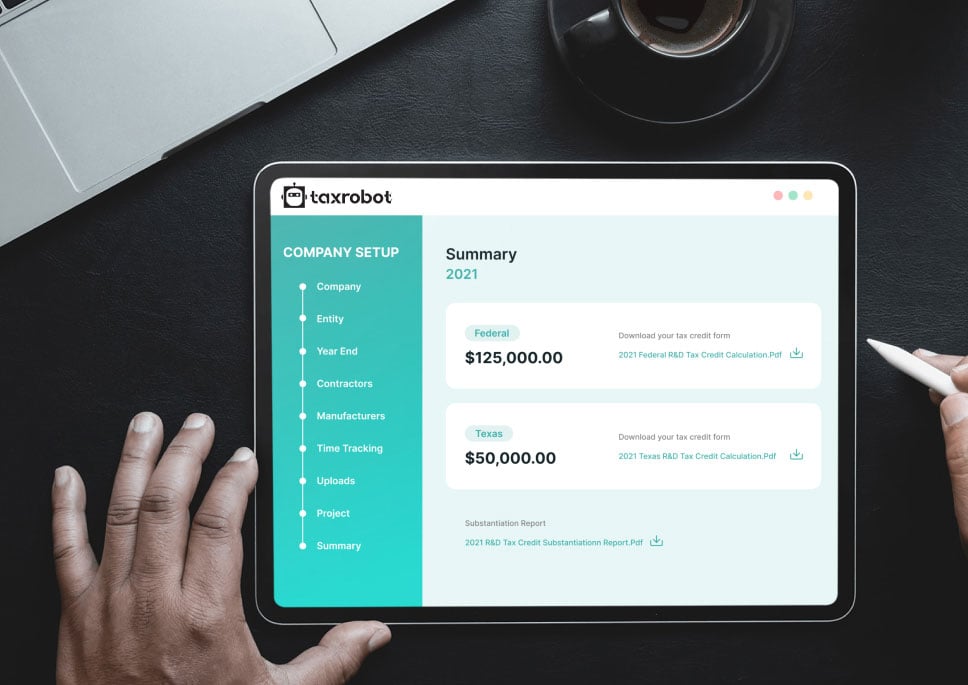Indiana R&D Credit
Let TaxRobot help you optimize your R&D tax savings.
Maximize your State Credits today!
Put the R&D tax credit process on autopilot.
Trusted By:








Indiana R&D Credit
Discover your eligibility for Indiana R&D tax credits and supercharge your enterprise.
Arizona’s Research and Development Incentive
Yes, there are R&D tax credits available to businesses in Indiana. In fact, there are two of these credits available on the state level and one on the federal level. With three potential credits available, it is even easier for companies to save money in Indiana. All they have to do is start investing in their own business process. Then, they can start to qualify for and claim these credits.
Indiana Research Expense Credit
The first credit is the Indiana Research Expense Credit. This credit is similar to the federal R&D tax credit in that it offers a tax credit for companies willing to invest money in research and development. The state government has a helpful fact sheet available for anyone interested in this credit.
Money spent on this is referred to as qualified research expenses. Indiana uses nearly the same definition as the federal government for this credit. However, Indiana calculates the credit differently. It offers a credit equalling 15% of the qualified research expenses that exceed a base amount of $1 million. This means that the percentage and the base amount differ from the numbers the federal government uses.
In addition, the expenses applicable for the Indiana tax credit must be made within Indiana. Proof of this is required alongside the application for the tax credit.
Indiana Research & Development Sales Tax Exemption
While the first Indiana R&D tax credit is similar to the federal one, Indiana also has a unique system. This one relates to sales taxes.
Specifically, Indiana allows for a 100% sales tax exemption on purchases relating to R&D equipment and property. When purchases like this are made, taxpayers can opt for a tax-exempt purchase when they buy it. However, if this isn’t available at the time, they can apply for a tax refund afterward.
These purchases have to be related to qualified R&D equipment and property. This includes equipment and property that hasn’t been used for another purpose previously and is made to conduct research and experimentation in the future.
Federal R&D Credit
Alongside the two types of Indiana tax credits, companies can also apply for the federal R&D tax credit. Since this uses many of the same features as the Indiana Research Expense Credit, applying for both is a no-brainer.
Eligible Businesses
All different types of businesses are eligible for this credit. This includes C-corporations, S-corporations, many types of LLCs, and partnerships.
The main stipulation is that the business needs to be engaged in research and development. They specifically need to have qualifying expenses in this category.
Eligible Expenses
Expenses eligible for the Indiana R&D tax credit are almost exactly the same as those eligible for the federal R&D tax credit. The two systems use the same definition with the stipulation that Indiana tax credit expenses must take place within Indiana. So, understanding the expenses that qualify for that will make it clear which expenses qualify in Indiana.
Maximize Your Indiana R&D Credit with TaxRobot
With three R&D tax credits available to Indiana businesses, getting the most out of these options can be overwhelming. It is easy to miss out on opportunities to claim certain expenses or accidentally claim expenses that don’t qualify. This could leave money on the table and create a problem that gets your application rejected.
Applications made with TaxRobot don’t have this problem. We use advanced software powered by AI to calculate tax credits and complete the applications. So, with us, you can always get the most out of your tax credit without making a mistake.
Find Out How Much You Could Save
Use our calculator to see how much you could save with TaxRobot and the Indiana R&D credit.
Take a sneak peak

- Limited Time Offer
- Simple Onboarding
- Easy to Use
R&D Tax Credits FAQs
The four-part test as outlined in the Internal Revenue Code is used to determine qualified R&D activity.
The Four-Part Test
1). New Or Improved Business Component
Creation of a new product, process, formula, invention, software, or technique; or improving the performance, functionality, quality, or reliability of existing business component.
- Construction of new buildings or renovation of existing buildings
- Invention of a software application
- Manufacturing of a new product or the improvement of the production process for an existing product
- Creation of design documentation
2). Technological In Nature
The activity fundamentally relies on principles of the physical or biological sciences, engineering, or computer science. A taxpayer does not need to obtain information that exceeds, expands or refines the common knowledge of skilled professionals in a particular field.
- Physics (relationship between mass, density and volume; loading as the
result of gravitational attraction) - Engineering (mechanical, electrical, civil, chemical)
- Computer science (theory of computation and design of computational systems)
3). Elimination Of Uncertainty
Uncertainty exists if the information available to the taxpayer does not establish the capability or method for developing or improving the business component, or the appropriate design of the business component.
- The capability of a manufacturer to create a part within the specified tolerances
- The appropriate method of overcoming unsuitable soil conditions during construction
- The appropriate software design to meet quality and volatility requirements
4). Process Of Experimentation
A process designed to evaluate one or more alternatives to achieve a result where the capability or method of achieving that result, or the appropriate design of that result, is uncertain as of the beginning of the taxpayer’s research activities.
- Systematic process of trial and error
- Evaluating alternative means and methods
- Computer modeling or simulation Prototyping Testing
The R&D tax credit is one of the most misunderstood tax incentives available. Considering the myriad of industries and activities that legally qualify for the credit, the term “research and development” is a misnomer. Additionally, the R&D tax credit requires specialized knowledge and technology to identify and calculate the incentive properly.
Companies of various industries are unaware that they are eligible to claim the R&D tax credit. Under the Internal Revenue Code’s definition of R&D, many common activities qualify. You can get tax benefits for industries including software, technology, architecture, engineering, construction, manufacturing, and more.
The R&D tax credit can be claimed for all open tax years. Generally, open tax years include the prior three tax years due to the statute of limitations period. In certain circumstances, the law allows businesses to claim the R&D tax credit for an extended period of time. It is common for companies to amend previous tax years to claim this benefit and reduce the maximum amount of tax liability.
Partnerships and S corporations must file this form to claim the credit. The credit will flow from the Form 6765, to the Schedule K-1, to the Form 3800 on the individual’s tax return. For individuals receiving this credit that have ownership interest in a partnership or S corporation, Form 6765 is not required on the individual return.
Individuals claiming this credit can report the credit directly on Form 3800, General Business Credit if their only source for the credit is a partnership, S corporation, estate, or trust. Otherwise, Form 6765 must be filed with the individual’s tax return (e.g. sole proprietorship).
For tax years prior to 2016, the credit can be used to reduce the taxpayer’s regular tax liability down to the tentative minimum tax. The credit cannot be used to offset alternative minimum tax. Beginning in tax year 2016, eligible small businesses have expanded utilization for the credit. For these eligible small businesses, the regular tax liability can offset alternative minimum tax using the “25/25” rule.
What our customers have to say
I highly recommend TaxRobot to anyone considering an R&D Tax Credit software to complete their analysis.

We decided to switch to TaxRobot… Best decision we’ve ever made. More affordable, and less complicated.

I couldn’t believe how easy it was! In under an hour, we saved enough money to hire a new employee.
